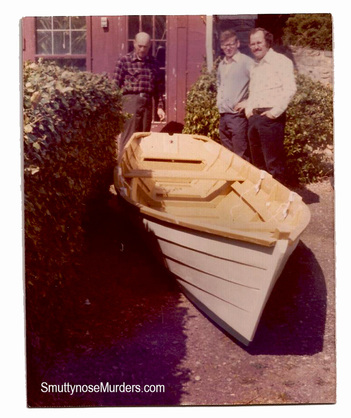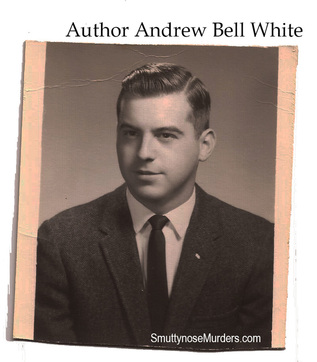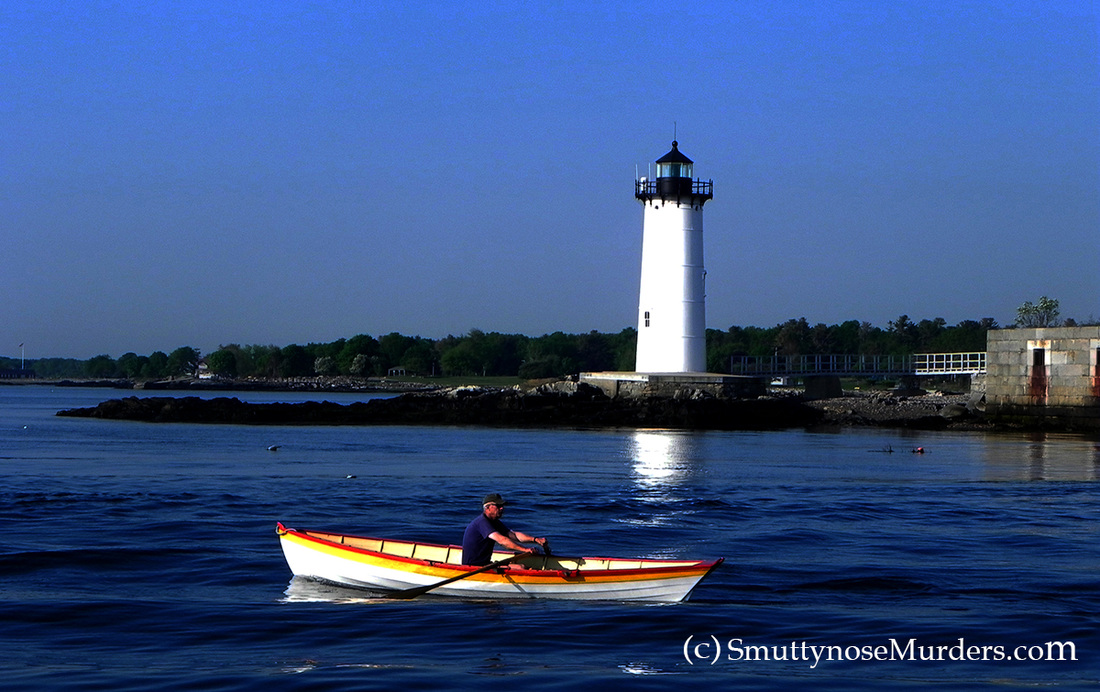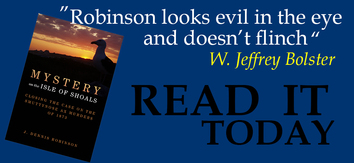By Andrew Bell White
Editor's Note: This great essay comes from a New Castle, NH resident and proves, once more, that dory fisherman Louis Wagner's deadly trip to Smuttynose Island in 1873 was entirely possible. Fisherman John Hontvet testified in court that he had made the trip by oar some 50 times. A recent re-enactment of Wagner's journey made for my book by 75-year old Dan O'Reilly took two hours and 14 minutes. Wagner was gone 11 hours. -- JDR
Editor's Note: This great essay comes from a New Castle, NH resident and proves, once more, that dory fisherman Louis Wagner's deadly trip to Smuttynose Island in 1873 was entirely possible. Fisherman John Hontvet testified in court that he had made the trip by oar some 50 times. A recent re-enactment of Wagner's journey made for my book by 75-year old Dan O'Reilly took two hours and 14 minutes. Wagner was gone 11 hours. -- JDR

I was 20 years old and had just finished my sophomore year at the University of New Hampshire. I proposed an idea to my friends for a friendly race to the Isles of Shoals, about eight miles away, later in the summer of 1960. I had been reading all of Celia Thaxter’s books about the Shoals, particularly the part about the murder on Smuttynose Island. The murderer, in that event, had rowed from Portsmouth to the Shoals and then back to New Castle and that may have inspired me to undertake this feat. Besides, I always liked to do things in a different and unusual manner, and wanted the challenge of conquering something difficult. If other people went to the Shoals in a power boat I wanted to do it a different way. In fact, the planning that went into this race was one of the most enjoyable parts of it.
The friends I recruited for this expedition were Norman Flagg, a few years younger than I who I did a lot of rowing with; Bob Calkins, a couple years younger and my best friend; and Mike LaRose, a year younger than me and a lobsterman who hauled his traps from a small boat. We used his boat for the second boat in the race. Mike was attending the Maine Maritime Academy and lived on Wentworth Road near where Spring Hill Road currently is located. Also recruited was John Beasley, a summer resident who stayed somewhere in the village, and Ben Ricker who was probably four years younger than I was, and we often rowed together. He spent a lot of time at the Horner’s house on Walbach Street as he lived nearby.
The boat I rowed belonged to my father which he built probably in the 1950s. It was modeled after the one which he had previously owned which had been built by Tommy Davidson. It was a 14’ wooden dory/skiff style boat and had two sets of oarlocks. A dory/skiff style boat has a pointed bow like a dory but a square stern like a skiff. The oars were 7 ½’ ash oars. The other boat belonged to Mike LaRose and was a similar style. When we were rowing we had two rowing and one using a steering oar, also known as a sweep oar, in the stern all the time. We switched positions every ½ hour so everyone got a ½ hour rest regularly. We had life preservers in the boat but didn’t wear them.
We did a lot of training before the race, not just that summer, but also for several previous years. We often rowed around New Castle Island as a team and up around the Portsmouth Naval Shipyard and over to Fishing Island, near Pepperrell Cove in Kittery Point, to practice our coordination and to strengthen ourselves.
"We did a lot of training before the Great Race of 1960."

My parents did not object to this race, as we’d done so much practicing before we left. In fact, father was happy that I decided to do this. We began the row at Bob Horner’s Wharf in New Castle. The weather was fair. The wind going out was a light NW wind and coming back it was SE wind. Nancy Horner accompanied us in her father’s 18-foot Lyman boat with a 25 horse outboard to be sure everything was all right. The two hour race started from Fort Point in New Castle and went to the bell buoy at Gosport Harbor at the Isles of Shoals. The second boat was a couple hundred yards behind us at the finish line. We probably went ashore on Star Island for a couple of hours and ate lunch which we had brought with us. The return row in the afternoon was a bit slower but not too much slower.
An article in a local paper dated August 6, 1960 had the following to say about the race:
New Castle – Portsmouth area boatmen were treated to an unusual sight here yesterday, when six local youths decided it was a good day for a rowboat race to the Isles of Shoals.
It took two hours for the six in two boats, to race from Ft. point Light to the bell buoy inside the Shoals. Finishing first were Andrew White, Norman Flagg and Robert Calkins. About 300 yards behind were Michael LaRose, John Beasley and Benjamin Ricker. Each boat had two on the oars and one on a sweep to set the course over the eight-mile distance.
The race of 1960 was such a success we decided to race again in the summer of 1961. This time we were going to leave from Bob Horner’s wharf and head out to Appledore Island at the Isles of Shoals. The crew was Bob Calkins, myself and Dick Wilder in the first boat and Norm Flagg, Mike LaRose and Dale Caswell in the other boat. I knew Dale from when I was the steward at the Portsmouth Yacht Club and he was the Assistant Steward. He often wore a cowboy hat, lived in Portsmouth and played a trumpet.
Since we were camping overnight on Appledore Island, we had a lot of gear to take. That included sleeping bags, the box compass out of my father’s boat, a chart, food, drinks, beer, Mike’s cherry-flavored rum, and someone brought brandy. Also Norm had one of his father’s 100-foot rolls of construction plastic. We loaded all our stuff into our boats (same ones we used the previous year) at Horner’s wharf in mid-afternoon. The boats were pretty well loaded with all our gear for a two day voyage.
We left late in the afternoon and rowed out past the 2KR whistling buoy near Whaleback Light and then headed straight for the nun buoy by Appledore Island. It took us probably three hours. We approached the island from the red nun buoy, went by that and in along the shore. The tide was running really hard and we had to row around Babb’s Rock to get into the cove. It was getting dark when we got in. There was a big field inside Babb’s Cove and we unloaded everything there. Mike’s boat was late coming in and it was dark when he got there. The thing we needed to do was decide how to camp. We unrolled the construction plastic and put some of it underneath us as a ground cloth and the rest we covered ourselves with to protect us from any rain which might come. We had some food, but mainly drank the alcoholic beverages on generally empty stomachs.
The next day some of us were rather hung-over, but still explored a few of the old houses, which were all in ruins, plus the Coast Guard boat house. It had two boat slips down by the water and was intact. There was poison ivy everywhere and I think one of our group got it bad. We stayed there most of the morning and left in the early afternoon. As none of us was in good shape for rowing back, I decided to cut Norm’s plastic into pieces and make sails out of it. I used oars to make the masts. We used the painters in the boats and extra rope that I’d brought to attach the sails to the oars. We sailed back very fast because a SE wind was blowing us right to New Castle. We had a hard time controlling the sweep oar as we were rolling along so fast. We landed on the beach by Norm’s house on Ocean Road in New Castle.
There was a welcome home party of very concerned parents when we arrived. Word had gotten around that we took alcoholic beverages with us. At least they knew why everyone looked rather pale.
It was a race to be remembered.
ABOUT THE WRITER: Andrew Bell White was born April 12, 1940. His family goes back to one of the original settlers on the island of New Castle, to Thomas Walford who arrived with Capt. Robert Gorges about 1623. His ancestors were generally employed as fishermen, sea captains, or merchants, up until recent times when his father, Frederick S. White, was employed at the Portsmouth Naval Shipyard as the Master Rigger. Andy has been rowing on the Piscataqua river since he was about ten years old, and has either owned his own boat, or shared his father's boat for his entire life. Andy and his wife are currently living on property in New Castle which has been in his family since 1849.
FOOTNOTE FOLLOWUP: We were just reminded by Andy's brother of another person in their family who rowed constantly out to the Shoals. Here's the info: Andy's great, great grandfather, Capt. John Amazeen (1815 - 1904) was a pilot on the Piscataqua River. Almost daily he would row out to the Isle of Shoals to meet the incoming ships and would then board the ships to guide them into Portsmouth Harbor. Rowing to the Shoals was a common practice a hundred and twenty years ago. -- Carol Hammond White
(c) 2015 Andrew Bell. All rights reserved. As seen on SmuttynoseMurders.com

 RSS Feed
RSS Feed
